The NVIDIA GeForce GTX 660 Review: GK106 Fills Out The Kepler Family
by Ryan Smith on September 13, 2012 9:00 AM ESTPower, Temperature, & Noise
As always, we’re wrapping up our look at a video card’s stock performance with a look at power, temperature, and noise. Unlike GTX 660 Ti, which was a harvested GK104 GPU, GTX 660 is based on the brand-new GK106 GPU, which will have interesting repercussions for power consumption. Scaling down a GPU by disabling functional units often has diminishing returns, so GK106 will effectively “reset” NVIDIA’s position as far as power consumption goes. As a reminder, NVIDIA’s power target here is a mere 115W, while their TDP is 140W.
| GeForce GTX 660 Series Voltages | |||||
| Ref GTX 660 Ti Load | Ref GTX 660 Ti Idle | Ref GTX 660 Load | Ref GTX 660 Idle | ||
| 1.175v | 0.975v | 1.175v | 0.875v | ||
Stopping to take a quick look at voltages, even with a new GPU nothing has changed. NVIDIA’s standard voltage remains at 1.175v, the same as we’ve seen with GK104. However idle voltages are much lower, with the GK106 based GTX 660 idling at 0.875v versus 0.975v for the various GK104 desktop cards. As we’ll see later, this is an important distinction for GK106.
Up next, before we jump into our graphs let’s take a look at the average core clockspeed during our benchmarks. Because of GPU boost the boost clock alone doesn’t give us the whole picture, we’ve recorded the clockspeed of our GTX 660 during each of our benchmarks when running it at 1920x1200 and computed the average clockspeed over the duration of the benchmark
| GeForce GTX 600 Series Average Clockspeeds | |||||
| GTX 670 | GTX 660 Ti | GTX 660 | |||
| Max Boost Clock | 1084MHz | 1058MHz | 1084MHz | ||
| Crysis | 1057MHz | 1058MHz | 1047MHz | ||
| Metro | 1042MHz | 1048MHz | 1042MHz | ||
| DiRT 3 | 1037MHz | 1058MHz | 1054MHz | ||
| Shogun 2 | 1064MHz | 1035MHz | 1045MHz | ||
| Batman | 1042MHz | 1051MHz | 1029MHz | ||
| Portal 2 | 988MHz | 1041MHz | 1033MHz | ||
| Battlefield 3 | 1055MHz | 1054MHz | 1065MHz | ||
| Starcraft II | 1084MHz | N/A | 1080MHz | ||
| Skyrim | 1084MHz | 1045MHz | 1084MHz | ||
| Civilization V | 1038MHz | 1045MHz | 1067MHz | ||
With an official boost clock of 1033MHz and a maximum boost of 1084MHz on our GTX 660, we see clockspeeds regularly vary between the two points. For the most part our average clockspeeds are slightly ahead of NVIDIA’s boost clock, while in CPU-heavy workloads (Starcraft II, Skyrim), we can almost sustain the maximum boost clock. Ultimately this means that the GTX 660 is spending most of its time near or above 1050MHz, which will have repercussions when it comes to overclocking.

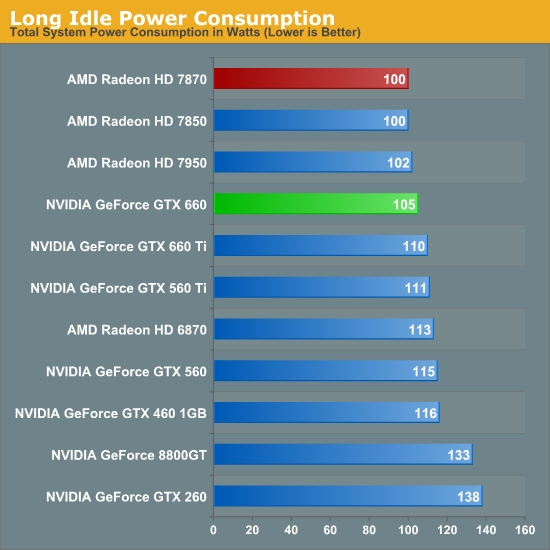
Starting as always with idle power we immediately see an interesting outcome: GTX 660 has the lowest idle power usage. And it’s not just a one or two watt either, but rather a 6W (all the wall) difference between the GTX 660 and both the Radeon HD 7800 series and the GTX 600 series. All of the current 28nm GPUs have offered refreshingly low idle power usage, but with the GTX 660 we’re seeing NVIDIA cut into what was already a relatively low idle power usage and shrink it even further.
NVIDIA’s claim is that their idle power usage is around 5W, and while our testing methodology doesn’t allow us to isolate the video card, our results corroborate a near-5W value. The biggest factors here seem to be a combination of die size and idle voltage; we naturally see a reduction in idle power usage as we move to smaller GPUs with fewer transistors to power up, but also NVIDIA’s idle voltage of 0.875v is nearly 0.1v below GK104’s idle voltage and 0.075v lower than GT 640 (GK107)’s idle voltage. The combination of these factors has pushed the GTX 660’s idle power usage to the lowest point we’ve ever seen for a GPU of this size, which is quite an accomplishment. Though I suspect the real payoff will be in the mobile space, as even with Optimus mobile GPUs have to spend some time idling, which is another opportunity to save power.
At this point the only area in which NVIDIA doesn’t outperform AMD is in the so-called “long idle” scenario, where AMD’s ZeroCore Power technology gets to kick in. 5W is nice, but next-to-0W is even better.
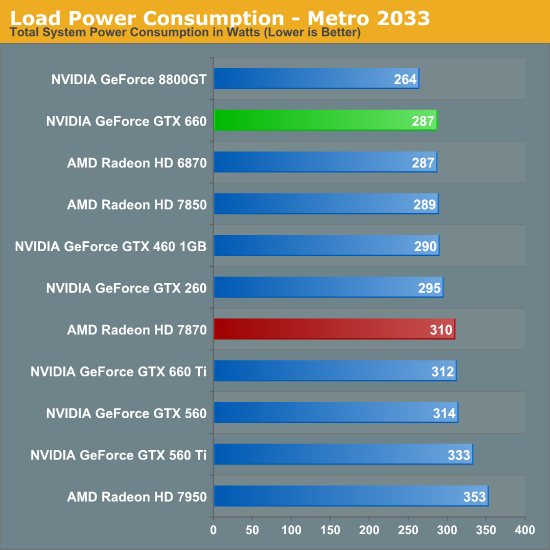
Moving on to load power consumption, given NVIDIA’s focus on efficiency with the Kepler family it comes as no great surprise that NVIDIA continues to hold the lead when it comes to load power consumption. The gap between GTX 660 and 7870 isn’t quite as large as the gap we saw between GTX 680 and 7970 but NVIDIA still has a convincing lead here, with the GTX 660 consuming 23W less at the wall than the 7870. This puts the GTX 660 at around the power consumption of the 7850 (a card with a similar TDP) or the GTX 460. On AMD’s part, Pitcairn is a more petite (and less compute-heavy) part than Tahiti, which means AMD doesn’t face nearly the disparity as they do on the high-end.

OCCT on the other hand has the GTX 660 and 7870 much closer, thanks to AMD’s much more aggressive throttling through PowerTune. This is one of the only times where the GTX 660 isn’t competitive with the 7850 in some fashion, though based on our experience our Metro results are more meaningful than our OCCT results right now.
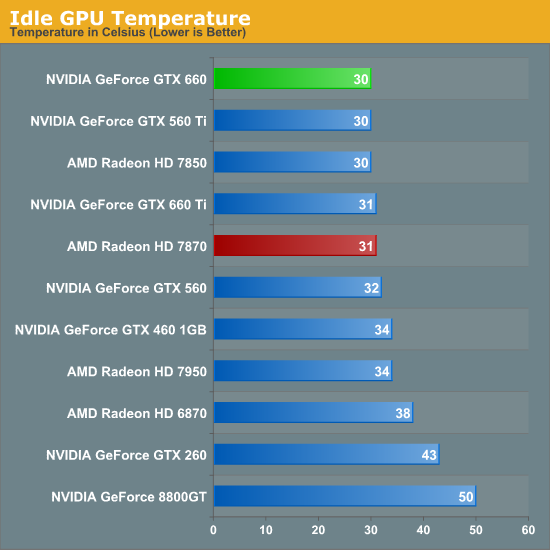
As for idle temperatures, there are no great surprises. A good blower can hit around 30C in our testbed, and that’s exactly what we see.
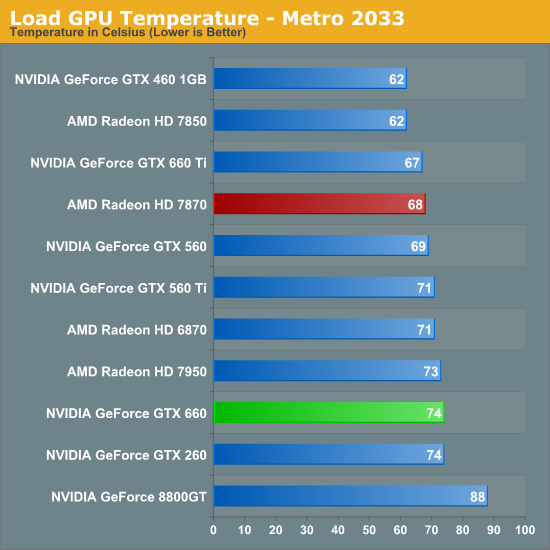
Temperatures under Metro look good enough; though despite their power advantage NVIDIA can’t keep up with the blower-equipped 7800 series. At the risk of spoiling our noise results, the 7800 series doesn’t do significantly worse for noise so it’s not immediately clear why the GTX 660 is 6C warmer here. Our best guess would be that the GTX 660’s cooler just quite isn’t up to the potential of the 7800 series’ reference cooler.
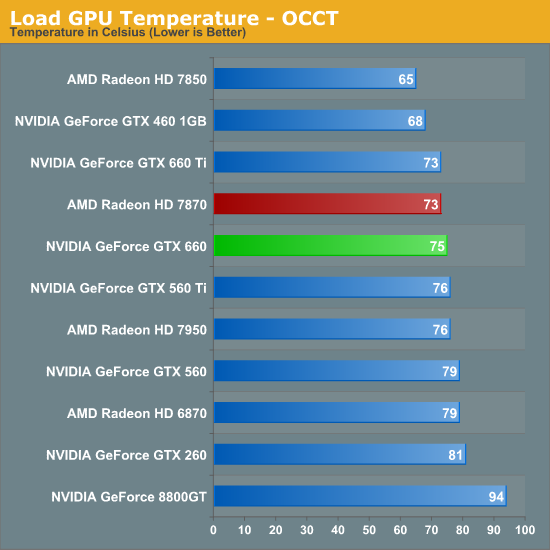
OCCT actually closes the gap between the 7870 and the GTX 660 rather than widening it, which is the opposite of what we would expect given our earlier temperature data. Reaching the mid-70s neither card is particularly cool, but both are still well below their thermal limits, meaning there’s plenty of thermal headroom to play with.
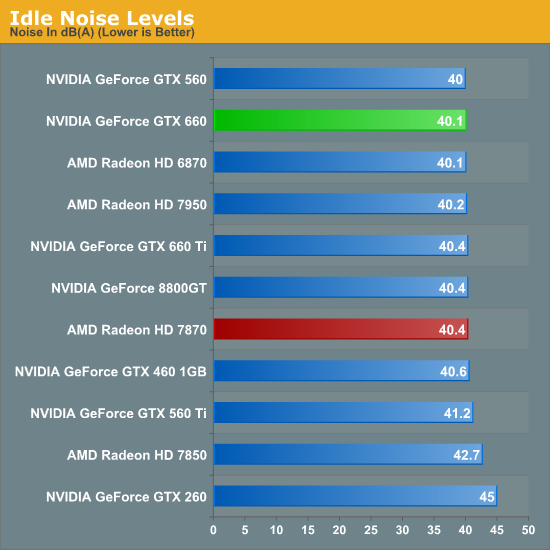
Last but not least we have our noise tests, starting with idle noise. Again there are no surprises here; the GTX 660’s blower is solid, producing no more noise than any other standard blower we’ve seen.
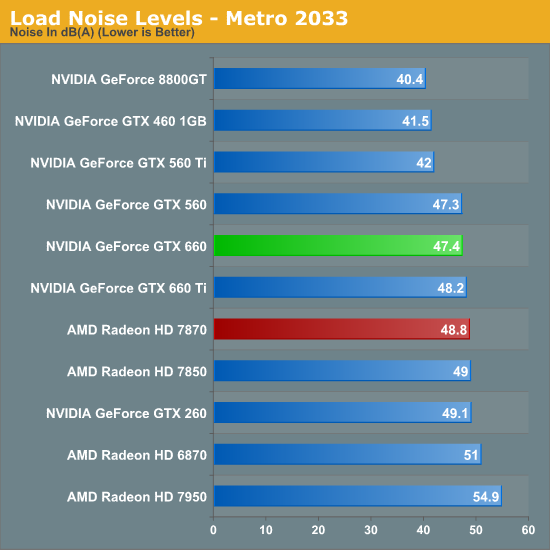
While the GTX 660 couldn’t beat the 7870 on temperatures under Metro, it can certainly beat the 7870 when it comes to noise. The difference isn’t particularly great – just 1.4dB – but every bit adds up, and 47.4dB is historically very good for a blower. However the use of a blower on the GTX 660 means that NVIDIA still can’t match the glory of the GTX 560 Ti or GTX 460; for that we’ll have to take a look at retail cards with open air coolers.
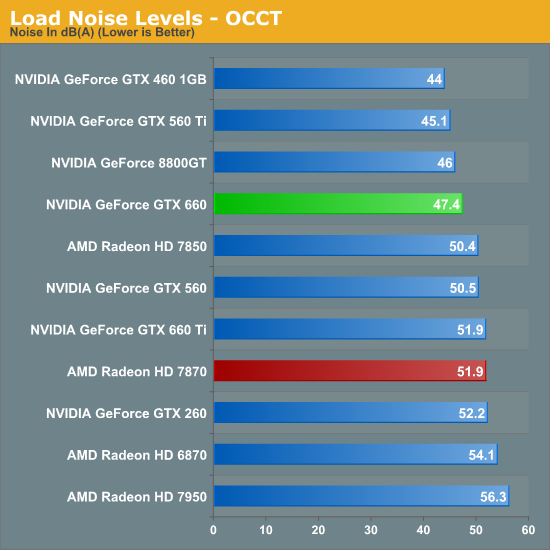
Similar to how AMD’s temperature lead eroded with OCCT, AMD’s slight loss in load noise testing becomes a much larger gap under OCCT. A 4.5dB difference is now solidly in the realm of noticeable, and further reinforces the fact that the GTX 660 is the quieter card under both normal and extreme situations.
We’ll be taking an in-depth look at some retail cards later today with our companion retail card article, but with those results already in hand we can say that despite the use of a blower the “reference” GTX 660 holds up very well. Open air coolers can definitely beat a blower with the usual drawbacks (that heat has to go somewhere), but when a blower is only hitting 47dB, you already have a fairly quiet card. So even a reference GTX 660 (as unlikely as it is to appear in North America) looks good all things considered.










147 Comments
View All Comments
Amgal - Friday, September 14, 2012 - link
A little off topic, but does anandtech have an article explaining TU's, SMXes, ROPs, shader clock, etc- basically explaining the new age graphics card architectures? I really enjoy their informative articles, and am having some trouble finding one on that area that isn't littered with incomprehensible computer science macroes. Thanks.pattycake0147 - Friday, September 14, 2012 - link
If the majority of cards available for sale have custom coolers, why are noise measurements taken for only the reference card? Especially when you've stated that you have custom cards in the lab.Jad77 - Friday, September 14, 2012 - link
but shouldn't AMD be releasing their next generation sometime soon?Patflute - Friday, September 14, 2012 - link
Months from now.rarson - Friday, September 14, 2012 - link
Can we please stop pretending that Nvidia's supply issues are anybody's fault but their own? Is it just a coincidence that Fermi and Kepler both were huge, horrible misfires or is it possible that Nvidia has struggled to design things that actually yield decently? Can we stop ignoring the fact that AMD has had an entire lineup of 28nm parts since March (you know, like 2 months before Kepler ever appeared in reasonable quantities)? Yeah, 28nm IS constrained, but other companies are still putting out parts. Nvidia can't put out parts because they have to throw them away. They're eating the wafers (they must be eating a lot of them if it took them this long to bring out a $300 part).I hope Nvidia can pull it together because at this rate, AMD's going to start launching a generation ahead of them (they already have all of the console business).
CeriseCogburn - Thursday, November 29, 2012 - link
nVidia dropped it production purchased spots, so you amd fanboys could blow giant dollars on nearly unavailable amd crap overpriced crashing non pci-e3 gen compliant video card trashyou did so
Well not you, but you know what I mean
Then nVidia released and 2 days before amd "magically" had supply in the channels.
If you're too stupid to know that - well - sorry since it's obvious
Then amd crashed it's prices 4 times, and amd fanboys were left raped
Then amd fired 10% more and now 15% more
I hope the amd golden parachutes for the criminal executives pleased you
What's your guess on the amd buyout rumors ?
My guess is that 3G of ram you fools tried to lie about having an advantage with the totaled and incapable gpu choking on dirt below it at frame rates no Skyrim player could possibly stand, won't be recieving "driver updates" for that "glorious future" when "new games" that "can make use of it" "become available" !
right fan boy ?
RIGHT
LOL
Have a nice cry, err I meant day.
Lepton87 - Friday, September 14, 2012 - link
This card is obviously slower than 7870.http://tpucdn.com/reviews/MSI/GTX_660_Twin_Frozr_I...
Just look at performance summaries from other sites. But the most glaring flaw of this review is NOT comparing it to OC'ed AMD cards. After OC even 7850 is going to obliterate this overpriced card with almost no clock headroom.
Lepton87 - Friday, September 14, 2012 - link
Unfortunately Anandtech is playing favourites. It's the only site that I know that has somewhat decent reputation that just couldn't admit that 7970GE is simply a faster card than GTX680 and now this....CeriseCogburn - Thursday, November 29, 2012 - link
Oh come on quarky, Crysis Warhead and Metro first on every review doesn't do it for you ?The alphabet here goes A for amd first, then C, the jumps to M, for amd , again and again.
Why so sour, because amd is almost toast ?
CeriseCogburn - Thursday, November 29, 2012 - link
100%, vs 103%, at a single resolution, the 1920x1200, when 1920x1080 shows another story, and the 7850 is down low at 85%.LOL - yeah amd fanboy, you sure are telling this amd fanboy site..
Can we count how CRAPPY amd drivers are ? Can we count no adaptive v-sync on amd crap cards, can we count no 4 monitors out of the box on amd cards, can we count no auto overclocking, can we count amd slashing it's staff and driver writers aka catalusy maker issues ?
Can we count any of that, or should we just count 3% ? LOL
Oh wait fair and above it all amd fanboy, I know the answer...
We will just count 3 more frames per 100 frame rate, at a single resolution, at your single link, and ignore everything else.
LOL
Thank you for your support.